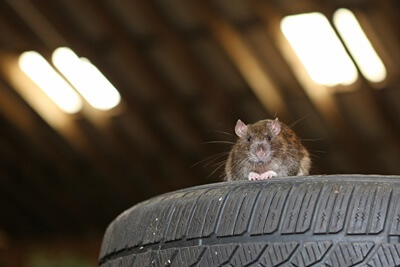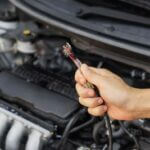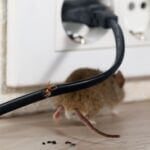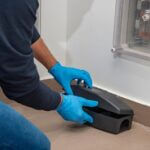Rats are opportunistic creatures that shelter in dark and unprotected areas, including cars. Once inside, they’ll chew the wiring and components of your vehicle, causing significant damage.
To remove rats from your car, clean and vacuum the interior, rinse the engine with a hose to clear out nesting material, and apply peppermint oil inside your vehicle to repel rodents.
Park your vehicle in an enclosed, sealed area to prevent rats from entering. To deter rodent activity, leave the lights on or install motion-activated lighting.
Many of the products available utilize toxic chemicals that can pose a safety hazard to pets and children. Fortunately, there are natural alternatives that can remove rats from vehicles.
What Attracts Rats To Cars?
Rats know how to take advantage of any unattended resources in their environment, so they’ll stay in areas where they’re guaranteed shelter, safety, and a reliable food source.
Since vehicles are warm and comfortable, they can be an attractive nesting site for rats, particularly if they aren’t used for extended periods.
Aside from providing warm shelters for rats, car interiors attract rodents due to the presence of wires. According to the Journal of the American Association of Laboratory Animal Science, rats have long incisors that continuously grow.
So, they constantly need to gnaw on objects to file their teeth and keep them from overgrowing. Wires inside cars are ideal for teeth grinding because their circular shapes make them easier to hold onto as they chew.
Unfortunately, if left unchecked, rats can chew up wires and other components of a car, causing costly damage. For this reason, it’s vital to eliminate rats hiding inside your vehicle and rat-proof the car to prevent any more rodents from getting inside.
Do Rats Build Nests Inside Cars?
The car’s engine compartment is an ideal nesting site for rats because it provides a warm environment, especially at night and during the cold seasons when temperatures drop significantly.
Additionally, the engine compartment provides a ready source for nesting material due to the numerous wires available. So, when rats get inside your car, it’s relatively easy for them to chew off the protective layer of the wires and use them to build nests.
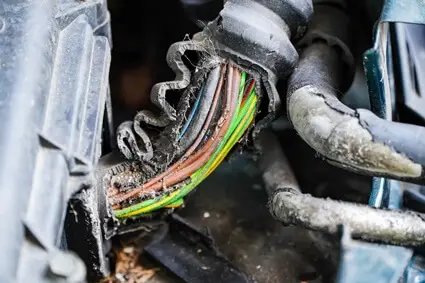
Where Do Rats Hide Inside Cars?
Cars have many cramped spaces where rats can easily squeeze through and hide, including:
Engine Compartment
The engine compartment is one of the warmest parts of a car since it generates heat when the vehicle is running. It’s also rarely accessed by humans, making it a private place to nest.
Trunk
The trunk of a car offers space and air for rats to hide in, especially if it hasn’t been used in a long time.
Dashboard Compartment
The dashboard compartment (glove box) is an ideal hiding location for rats, particularly if cluttered with too many things and not cleaned regularly.
It can also grow warm during the summer as the car’s interior heats up.
Under The Seats
Car seats have tiny spaces underneath them that rats can easily squeeze through.
Incidentally, the area underneath your car seat is one of the hardest to access when cleaning, making it a relatively safe location for rats to hide in for long periods.
Air Vents
While the slits on your car’s air vents might seem too small, you can’t underestimate a rat’s ability to find its way inside them. After all, rats can squeeze through openings as small as ½ an inch in diameter.
As long as they can get their head through the vents, rats have no problem making your car’s air conditioning their new home.
Signs of Rats Inside Your Car
It can be difficult to spot rats in your car because most cars have cramped interior spaces that provide hiding spots.
However, even if you haven’t seen any rats inside your car, other tell-tale signs can alert you about an unwelcome guest, including the following:
Foul Smell
Rats aren’t sanitary creatures, as they wade through all kinds of dirt, grime, and filth in search of food.
So, if rats live inside your car, one of the first things you might notice is a strong, unpleasant smell.
Rats leave droppings and urine wherever they visit, so you might also notice a pungent ammonia-like smell permeating your car.
Chew Marks
As mentioned, rats are relentless gnawers who must grind their teeth against objects to keep them in shape.
Therefore, if you notice any chew marks on your car seats, safety belts, and floor mats, the chances are that a rat (or rats) is living inside your vehicle.
Faulty Car Components
When rats enter your car, the electrical wires inside your engine and display will likely be one of the casualties of their chewing habits.
So, if your engine is suddenly failing even though you had a recent oil change, or your display is malfunctioning more often than it used to, it might be due to damage by rats.
Noise
Rats can be pretty noisy, especially when chewing on wires. If you notice scratchy noises or squeaking inside your car, this is a sign that rats are living there.
How To Remove Rats From Your Car
It’s essential to deal with a rat infestation inside your car as soon as you recognize it. This will prevent it from becoming a protracted problem. Below are measures you can take:
Thorough Cleaning
Start by vacuuming all the areas inside the car to remove droppings and nesting materials that may have been left behind.
After you’ve cleaned the engine, hose down the exterior compartment.
Natural Rat Repellent
Rodent control methods like poison and traps aren’t ideal for removing rats from cars. When attempting to rid a car of rats, use natural repellents like peppermint oil.
Rats find the smell of peppermint oil unpleasant since it contains compounds that irritate their nostrils. This makes peppermint a safer alternative to rat poison.
To get rid of rats using peppermint oil, douse several balls of cotton with peppermint oil and place them in all potential hiding spots for rats, including:
- Inside the glove box.
- Under car seats.
- Inside the dashboard compartment.
- Inside the trunk.
Draw up the windows and close the door to your car to prevent the peppermint oil from evaporating. The potent smell of peppermint will drive out any remaining rats from your vehicle.
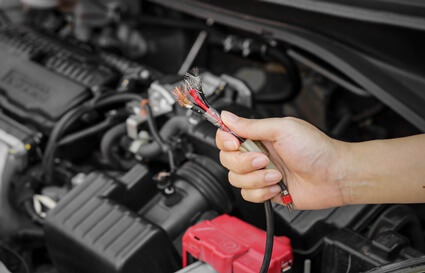
How To Make Your Car Rat-Free
Even after getting rid of rats from your vehicle, there’s always a possibility they’ll return unless you take the necessary steps to rat-proof your car.
Here are things you can do to keep rats at bay:
Park Your Car in A Closed Garage
Parking your car in a closed garage helps keep rats away, as you can more easily manage and control the garage area.
For instance, you can keep it locked after you park your car to prevent rats from entering and clean it regularly to remove any accumulated dirt.
However, even if you don’t have access to a closed garage, you can minimize the chances of rats entering your vehicle by keeping garbage bins away.
You may also clear any potential hiding areas, such as vegetation.
Remove Food Sources
Rats will make a home anywhere they can access a source of food. So, if you often eat inside your car, any food crumbs or spillages left uncleared can attract rats.
To prevent this, clear your car of clutter and vacuum everywhere to remove food debris that might have fallen while eating.
Also, avoid feeding your pets near your car since any crumbs you leave behind might lure rats.
Garage Lights On
Rats feel safer in the dark and often forage for food at night. Most rats avoid being exposed in the open, so they won’t come out when the environment is well-lit.
For this reason, leaving your car hood up and the lights in your garage on during the night can discourage rats from nesting inside your car.
Check Your Car
An unused car is attractive to rats and can quickly turn into a breeding ground. Therefore, ensure your vehicle isn’t left unattended for long periods.
Even if you’re not taking your car for a drive, switching the engine on and letting it roar can scare off rats and prevent them from making your vehicle their new home.

